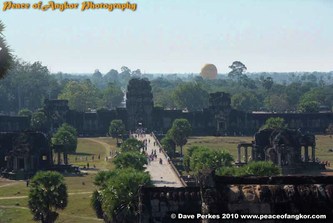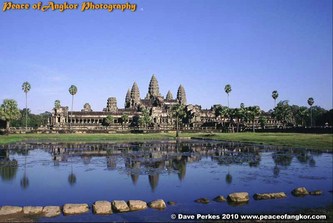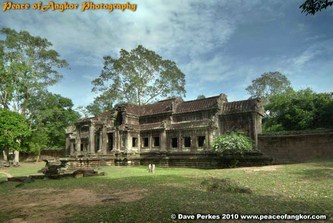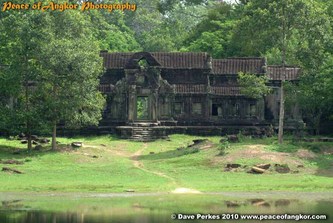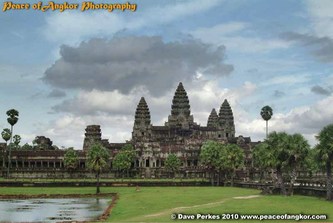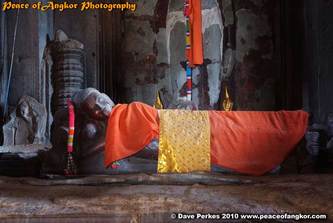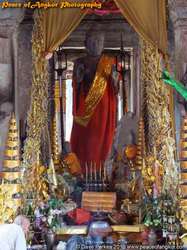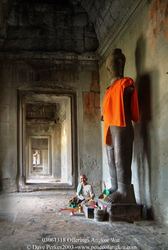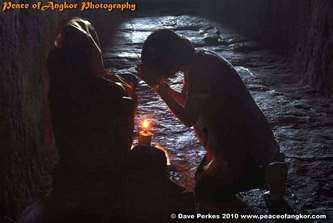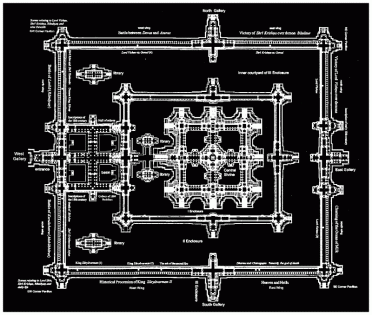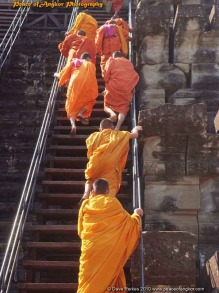PEACE OF ANGKOR PHOTOGRAPHY
ANGKOR WAT the worlds largest religious building
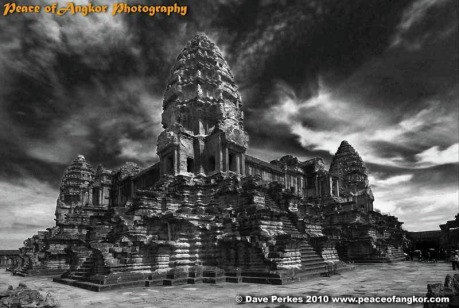
Angkor Wat with dramatic sky
Angkor Wat, the largest religious monument in the world is so big as to be hard to take in at once.The 200 metre wide moat and causeway with the 350 metre entrance portico is impressive enough, but the grandeur within its walls is truly stunning.
Built as a funerary temple for King Suryavaraman II; Angkor Wat represents the pinnacle of achievement in Khmer temple building.
It is South East Asia's biggest tourist draw; being visited by more than two million tourists each year.
Angkor's popularity is justified as it is the worlds largest and arguably the most spectacular religious monument. Over one kilometre of spectacular carvings lie within its outer galleries and a vast labyrinth of passages, courtyards and the five lotus flower towers at its centre.
Built as a funerary temple for King Suryavaraman II; Angkor Wat represents the pinnacle of achievement in Khmer temple building.
It is South East Asia's biggest tourist draw; being visited by more than two million tourists each year.
Angkor's popularity is justified as it is the worlds largest and arguably the most spectacular religious monument. Over one kilometre of spectacular carvings lie within its outer galleries and a vast labyrinth of passages, courtyards and the five lotus flower towers at its centre.
You are in Angkor Wat- Angkor Wat - Angkor Thom - Bayon - Ta Prohm - Preah Khan - Eastern Temples
Angkor Wat: the outer precincts
The upper level of Angkor Wat consists of 5 towers which represent the five peaks of the mythical Mount Meru. This was considered by Hindus as being the centre of the known universe. The outer grounds represent the known world and the moat, the oceans.
Angkor Wat is unusual as it faces west. Visitors usually enter across a 200 metre wide causeway spanning the moat, which extends 1.3 kms wide by 1.5Kms long.
Angkor Wat is a vast monument that requires time and the benefit of a guide, to enjoy and bring the stones of Angkor to life!
Angkor Wat is unusual as it faces west. Visitors usually enter across a 200 metre wide causeway spanning the moat, which extends 1.3 kms wide by 1.5Kms long.
Angkor Wat is a vast monument that requires time and the benefit of a guide, to enjoy and bring the stones of Angkor to life!
The bas relief galleries.
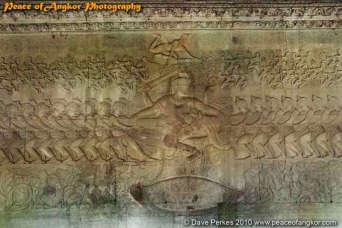
The Churning of the Ocean relief
The bas releifs extend for over one kilometre around the inner galleries of Angkor Wat. The reliefs depict the great Hindu religious themes and the battles of the Khmer against Dai Viet from Northern Vietnam.
The most important relief Churning of the Ocean of Milk; is situated in the East Gallery, South Wing of Angkor Wat. It represents the Hindu legend where Gods had joined with Naga Vasuki (the serpent) in order to gain nectar by the churning of the ocean.
The Naga wrapped around the pillar which represented Mount Meru which spinned on the turtle that supported it. The nectar would appear when the ocean mostly dried up.
The birth of the Thousands of Apsaras (goddesses of mist) can be seen above the Gods and Demons These were created just before the nectar. Apsara dance is considered a holy dance for prosperity and luck. It is still practiced today. Visitors can see traditional Apsara Dance shows in various locations in Siem Reap.
The most important relief Churning of the Ocean of Milk; is situated in the East Gallery, South Wing of Angkor Wat. It represents the Hindu legend where Gods had joined with Naga Vasuki (the serpent) in order to gain nectar by the churning of the ocean.
The Naga wrapped around the pillar which represented Mount Meru which spinned on the turtle that supported it. The nectar would appear when the ocean mostly dried up.
The birth of the Thousands of Apsaras (goddesses of mist) can be seen above the Gods and Demons These were created just before the nectar. Apsara dance is considered a holy dance for prosperity and luck. It is still practiced today. Visitors can see traditional Apsara Dance shows in various locations in Siem Reap.
Sculpture and Religion within Angkor Wat
The dressing of the figures and shrines and praying to the Buddha figures are an important part of the Buddhist rituals.
Many thousands of of Cambodians visit Angkor Wat to pay homage to the Buddha. The spiritual significance of this site cannot be underestimated. During Buddhist festivals, Angkor Wat is filled with pilgrims and monks. For many rural Cambodians and monks it is a once in a lifetime visit. It is a very sacred place; so visitors should be respectful in their actions and dress.
It is a sad fact that most of the original sculptures have either been looted or stored away for safe keeping. The Gallery of 1000 Buddhas on the Second Level, only has a fraction of what was once originally there.
Many thousands of of Cambodians visit Angkor Wat to pay homage to the Buddha. The spiritual significance of this site cannot be underestimated. During Buddhist festivals, Angkor Wat is filled with pilgrims and monks. For many rural Cambodians and monks it is a once in a lifetime visit. It is a very sacred place; so visitors should be respectful in their actions and dress.
It is a sad fact that most of the original sculptures have either been looted or stored away for safe keeping. The Gallery of 1000 Buddhas on the Second Level, only has a fraction of what was once originally there.
